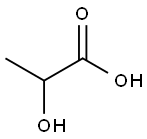DL-Lactic acid , ACS,≥85% , 50-21-5
Synonym(s):
DL -Lactic acid;2-Hydroxypropionic acid
CAS NO.:50-21-5
Empirical Formula: C3H6O3
Molecular Weight: 90.08
MDL number: MFCD00004520
EINECS: 200-018-0
| Pack Size | Price | Stock | Quantity |
| 500G | RMB96.00 | In Stock |
|
| 2.5KG | RMB388.80 | In Stock |
|
| others | Enquire |
PRODUCT Properties
| Melting point: | 18°C |
| alpha | -0.05 º (c= neat 25 ºC) |
| Boiling point: | 122 °C/15 mmHg (lit.) |
| Density | 1.209 g/mL at 25 °C (lit.) |
| vapor density | 0.62 (vs air) |
| vapor pressure | 19 mm of Hg (@ 20°C) |
| FEMA | 2611 | LACTIC ACID |
| refractive index | n |
| Flash point: | >230 °F |
| storage temp. | 2-8°C |
| solubility | Miscible with water and with ethanol (96 per cent). |
| pka | 3.08(at 100℃) |
| form | syrup |
| color | Colorless to yellow |
| Specific Gravity | 1.209 |
| PH | 3.51(1 mM solution);2.96(10 mM solution);2.44(100 mM solution); |
| Odor | at 100.00 %. odorless |
| Odor Type | odorless |
| Water Solubility | SOLUBLE |
| Merck | 14,5336 |
| JECFA Number | 930 |
| BRN | 1209341 |
| Dielectric constant | 22.0(16℃) |
| Stability: | Stable. Combustible. Incompatible with strong oxidizing agents. |
| InChIKey | JVTAAEKCZFNVCJ-UHFFFAOYSA-N |
| LogP | -0.72 |
| CAS DataBase Reference | 50-21-5(CAS DataBase Reference) |
| NIST Chemistry Reference | Propanoic acid, 2-hydroxy-(50-21-5) |
| EPA Substance Registry System | Lactic acid (50-21-5) |
Description and Uses
Lactic acid (2-hydroxypropionic acid, CH3-CHOH-COOH) is the most widely
occurring organic acid in nature. Due to its chiral a-carbon atom, lactic acid (LA)
has two enantiomeric forms. Of these, L-(+)-lactic acid is more important in food and pharmaceutical industries because humans have only L-lactate
dehydrogenase. The chemical behavior of lactic acid is mostly determined
by the two functional groups. Besides the acidic character in aqueous
medium, the bifunctionality (a terminal carboxylic acid and a hydroxyl group)
allows lactic acid molecules to form ‘‘interesters’’ such as the cyclic dimers, the
trimers, or longer lactic acid oligomers.
After its first isolation by the Swedish chemist Scheel in 1780 from sour milk,
lactic acid has been produced commercially since the 1880s in the United States
and later in Europe. Worldwide, lactic acid production was approximately
250,000 metric tons per year in 2012 and is expected to reach 330,000
metric tons by the year 2015, with an average price of 1.25 US$ per
kilogram in 2013 (food grade, 80–85 % purity).
Approximately 85 % of the demand for LA is from the food industry. The
primary use of lactic acid is as a pH-adjusting agent in the beverage sector and as a
preservative in the food industry. It is included in the Generally Recognized as
Safe (GRAS) by the U.S. Food and Drug Administration [158] as a food ingredient
and was deemed safe by the European Food Safety Authority as well [159]. The
acceptable daily intake for LA was defined by the Joint FAO/WHO Expert
Committee on Food Additives as ‘‘not limited,’’ and it is also supported by the
Scientific Committee of Food.
In recent decades, the consumption of lactic acid due to its novel applications
has grown quite rapidly, by 19 % per year. Nonfood use of lactic acid for polymer production contributes to this growth. Biodegradable polylactic acid is
considered to be an environmentally friendly alternative to other plastics from
petroleum. It is used in various fields, including drug delivery systems,
medical devices, fibers, and packaging materials.
Lactic acid can be produced via chemical synthesis or carbohydrate fermentation.
The chemical route has various issues, including toxic raw materials, low
conversion rates, and especially the inability to produce the optically pure isomer.
Therefore, approximately 90 % of lactic acid worldwide is produced by biotechnological
processes, namely fermentations using renewable resources, which
is relatively fast, economical, and able to supply selectively one or two stereoisomers
of lactic acid.
Prostaglandin E1 analogue
Safety
| Symbol(GHS) |  GHS05 |
| Signal word | Danger |
| Hazard statements | H315-H318 |
| Precautionary statements | P264-P280-P302+P352-P305+P351+P338-P332+P313-P362+P364 |
| Hazard Codes | Xi,C |
| Risk Statements | 38-41-34-37/38 |
| Safety Statements | 26-39-45-36/37/39 |
| RIDADR | 3265 |
| WGK Germany | 2 |
| RTECS | OD2800000 |
| F | 3 |
| TSCA | Yes |
| HazardClass | 8 |
| PackingGroup | III |
| HS Code | 29181100 |
| Hazardous Substances Data | 50-21-5(Hazardous Substances Data) |



